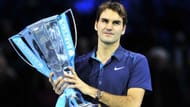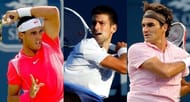Roger Federer, Rafael Nadal and Novak Djokovic make up the Big 3 of tennis, and that has come to define the current generation of the sport. In the Open Era have we ever seen a group of players dominate tennis the way this group has?
The three make for by far the most dominant group ever in tennis. They have held a virtual monopoly on the big-name tournaments; their performance at Grand Slams, Masters, ATP 500s and ATP Finals is unparalleled.
But just how dominant has the Big 3 been? Let's look at the breakdown of the stats and compare them with previous 'golden generations' in the Open Era - Jimmy Connors / Bjorn Borg / John McEnroe, Mats Wilander / Ivan Lendl / Boris Becker / Stefan Edberg and Jim Courier / Pete Sampras / Andre Agassi.
Grand Slam dominance

Federer won his first Grand Slam at Wimbledon in 2003. There have been 58 Grand Slam tournaments after that, including the 2018 Australian Open.
The Big 3 have won an astonishing 48 of the last 59, for a winning percentage of 81.4%. The breakup of those wins is in the table below.

In the last 15 years, only seven other people have won Grand Slams, and only two of them have won multiple Slams. Andy Roddick (US Open 2003), Gaston Gaudio (French Open 2004), Marat Safin (Australian Open 2005), Juan Martin Del Potro (US Open 2009) and Marin Cilic (US Open 2014) have won a single Grand Slam each, while Andy Murray (US Open 2012 and Wimbledon 2013, 2016) and Stan Wawrinka (Australian Open 2014, French Open 2015 and US Open 2016) have won three each.
These seven are the fortunate ones outside the Big 3 to have won a Grand Slam. Even more astonishing is the fact that Federer, Nadal and Djokovic have occupied 72 of the 118 spots available in the 59 Grand Slam finals (for a success rate of 61%).
The Big 3 have played against each other in 19 of the 59 Grand Slam finals, and there have been only 5 Grand Slam finals without a member of the Big 3.
If we compare previous groups of dominant players using the same logic (from first Grand Slam win to the last), then it is clear how dominant the current Big 3 have been.


It has to be noted that during the era of Connors, Borg and McEnroe, the Australian Open was not very popular and these three did not make many trips Down Under.The same is true for the early career of Lendl.

Additionally, the Big 3 have all won a Career Slam, joining Agassi and Rod Laver as the only five players to achieve the feat in the Open Era.

The Big 3 have won 13 of 15 Australian Opens since 2004, 13 of 14 French Opens since 2005, 12 of 14 Wimbledon titles since 2003, and 10 of 14 US Opens since 2004.

This type of Grand Slam dominance has not been witnessed before.
ATP Masters 1000 dominance

The Masters series has gone through several changes since it started in 1970. Today, the Masters series is comprised of the nine top tournaments, which come second only to the Grand Slams and the ATP Finals.
Federer won his first Masters tournament in 2002 and there have been 140 tournaments after that. The Big 3 have won 87 of them, for a winning percentage of 61.7%. Nadal and Djokovic have both won a record 30 Masters titles and Federer has won 27.
The table below shows the comparison of this success rate with that of the previous generations.

Additionally, the Big 3 have made the finals of 107 of the 141 Masters tournaments.
ATP Finals Dominance

The year-end ATP Finals has been won by the Big 3 a total of 11 times in the last 15 years. Federer has won it a record 6 times while Djokovic has won it 5 times. Lendl and Sampras also have 5 victories.
Connors, Borg, and McEnroe had won the tournament 6 times in 8 years, while Lendl, Becker, and Edberg had won it 9 times in 15 years. Sampras and Agassi had won it 6 times in 10 years.
Nadal, Wilander and Courier have never won the ATP Finals.
There have been five Big 3 finals. But for Connors, Borg, and McEnroe, there was only a single Connors-Borg final. Wilander, Lendl, Becker and Edberg had five finals among them and Courier, Sampras and Agassi had two finals.

Federer has qualified for the tournament 15 times and played in the final on 10 occasions. Lendl qualified 12 times and played in the final 9 times.
The longest streak for the Big 3 is six titles - from 2010 to 2015. The next longest streak is five titles by Lendl, Becker and Edberg, from 1985 to 1989.
Tournament level dominance

The Big 3 hold a number of records at the tournament level as well.
- ATP 500: Federer holds the record with 20 titles
- Australian Open: Djokovic and Federer with 6 titles
- French Open: Nadal with 10 titles
- Wimbledon: Federer with 8 titles
- US Open: Federer with 5 titles, shared with Jimmy Connors and Pete Sampras. Federer is the only one to win 5 consecutive titles.
- Nadal is the only player to win a title 10 times and he has done it at three tournaments (French Open, Monte Carlo Masters and the Barcelona Open).
The table below lists the other tournament records held by the Big 3.

Note: Djokovic shares the Miami Open record with Agassi and the Shanghai Masters record with Murray.
The sheer frequency of individual tournament titles exemplifies the high consistency the group plays at.
Overall dominance

The Big 3 have won a total of 239 titles - Federer with 96, Nadal with 75, and Djokovic with 68. Each one has helped his respective country win the Davis Cup title too.
Since Federer ascended to to the top of the rankings on February 2, 2004, the No. 1 spot has been held exclusively by the Big 3 and Murray: an amazing figure of 736 total and consecutive weeks. Federer leads with 305 weeks as No. 1, followed by Djokovic with 223 weeks, Nadal with 167 weeks, and Murray with 41 weeks.
The table below shows the total and consecutive weeks at No. 1 for each group.

The top two spots in the rankings were held by the Big 3 for more than a decade, from July 25, 2005 to November 24, 2015.
Meanwhile, Federer has the longest winning streak on grass and hard courts, 65 and 56 respectively. Nadal has the longest winning streak on clay at 81.
Additionally, the Big 3 are the top three on the all-time earnings list: Federer, Djokovic and Nadal, in that order.
End of an era?

As is usually the norm, younger players replace older ones. Generally, players start to think about retirement once they cross 30 due to the wear and tear of the professional tour. Retirement comes knocking on the door when they can no longer match the younger players on a consistent basis.
Borg was an exception as he retired at 26 due to burnout. Connors retired at 44, but did not win any title in the last 7 years of his career. Edberg and Courier retired at 30 each, Becker and Sampras at 32, McEnroe at 33, Lendl at 34, and Agassi at 36. At the time of their retirement none of these players were dominating the sport as they once did.
The Big 3 are all in their 30s. Nadal is 31 and Djokovic is 30, while Roger Federer is an ancient 36. And yet, even as of today, only Murray and Wawrinka have been able to challenge the Big 3 on a consistent basis. Many experts club Murray with the Big 3 and call them the Big 4. With Stan Wawrinka, it becomes the Big 5.
Rather than being pushed out by the next generation of players, the Big 5 are being pushed out by injuries. Federer and Nadal were out with injury in 2016 but made stunning comebacks in 2017. Djokovic, Murray, and Wawrinka were all injured in 2017, with Nadal getting injured again near the end of 2017.
Murray had a hip operation and may not be the same again. Djokovic had a procedure on his elbow and it remains to be seen whether he can come back at the same level as before. Wawrinka has been a pale shade of his former self after his knee operation. Nadal has continuing knee and leg problems, while Federer has a sensitive back.
Keeping in mind all these physical problems, is it right to say that the era of the Big 3, 4, 5 is over? We did see a return of the Fedal duopoly in 2017 but we'll have to wait and see if the group can resume their prior dominance.

The much touted NextGen has been on the sidelines for some time now. Grigor Dimitrov, Nick Kyrgios, Alexander Zverev, Dominic Thiem and others have been knocking on the door for a while now. Although they have won tournaments sporadically and beaten the Big 3, their consistency on the big stage has been found wanting.
These young guns are still touted to be the players that will take over from the Big 3, but so far they have not been able to take advantage of the top dogs' age and injuries.
All that said, time is catching up with the greats, and some time in the future we will bid them a sad farewell. Whether they are pushed out unwillingly or they hang up their rackets on their own terms, they have already proven that they are the most dominant group of players to ever play the game of tennis.
It will be some time before we see a group of that caliber again, if ever.
Who Are Roger Federer's Kids? Know All About Federer's Twins
